In the 1970s in Victoria about 60% of Municipal Sewerage Authorities used secondary treated wastewater to irrigate pastures, sometimes grazed by livestock. At the start of the decade, extensive trials were carried out in south-east Melbourne testing the suitability of treated wastewater for irrigating agricultural and horticultural crops. In 1973 the Forests Commission Victoria started trials to test the irrigation of planted trees with wastewater. This work followed studies in the USA, pioneered by the Pennsylvania State University in the early 1960s, that indicated the benefits of using natural forests for the renovation of wastewater. The trials in Victoria were ramped up in 1977 with support from the Reclaimed Water Committee of the Ministry of Water Resources and Water Supply. (A member of the committee, John Mann, Director of Water Resources, told the Senate Committee on Natural Resources in 1977 that Victoria hoped to have the technical expertise to re-use almost all of the State’s wastewater by the end of the century.) Other field trials were conducted by the Melbourne Metropolitan Board of Works (MMBW, at Carrum and at Werribee), and by the CSIRO.
Tab
As a precursor, the Forests Commission Research Branch had carried out trials in 1972 and 1973 in cooperation with the Department of Agriculture, at the Animal and Irrigated Pastures Research Institute at Kyabram, to test the feasibility of growing short rotation tree plantations under irrigation (agricultural water), to produce wood fibre. This work was triggered, in part, by the 1973 oil crisis that saw the international oil price skyrocket, leading countries to think about sources of fibre for production of biofuel. Forty-one species were evaluated with preference for species that could provide wood products for local and regional markets. Species such as Flooded Gum ( Eucalyptus grandis) and Sydney Blue Gum ( E. saligna) showed early promise.
In 1972, consultants to the Swan Hill Sewerage Authority sought advice from the Forests Commission on the potential for irrigating tree plantations with municipal wastewater. Other enquiries followed. Subsequently, trials were established at municipal wastewater treatment sites by the Forests Commission at Swan Hill (1973, 1974), Cobram (1975), and Mildura (1976). Early results from these trials were used to select species for further testing at Mildura (1977, 2.4 ha), Horsham (1977, 1.2 ha), Dutson Downs (1978, 2.0 ha), and Robinvale (1979, 1.6 ha). 1973 was one of the wettest years on record and travel and establishment was made difficult by widespread flooding across the Goulburn Valley. A team of Aboriginal workers assisted with the planting at Robinvale.
A new trial followed in 1980 at Wodonga (1.1 ha) in collaboration with the Albury Wodonga Development Corporation – this was the most sophisticated and intensively monitored of all the trials, with six tree species plus bare earth and pasture controls in a fully randomized, replicated layout. Measurements at age 14 years at the Wodonga trial showed mean annual increments (MAI) of 41 and 31 cubic metres per hectare per annum for Flooded Gum and Sydney Blue Gum, respectively. One Flooded Gum was measured at 15.5 metres tall at age 3.5 years.
The largest research project irrigated with wastewater was established at Werribee in 1990, supported by the National Afforestation Program ($70,000 research grant) and done in cooperation with the MMBW. At the time the Werribee farm of 11,000 hectares treated about 500 million litres of sewage daily (approx. 55% of Melbourne’s output). After passing through lagoons, grass filtration (in winter) or pasture irrigation (in summer), the treated sewage was discharged into Port Phillip Bay. The MMBW had set up species screening trials at Werribee in 1973. Forward nearly two decades, their thinking was that trees could be a viable option to use more sewage than the irrigated pastures or, alternatively, trees could be planted at the lower end of the flood irrigation bays to absorb excess runoff rather than re-treating the excess by pumping it to lagoons. The idea was promoted by the National Party’s spokesman on Conservation, Forests and Lands, Mr Evans, in a newspaper report (“The Age”, 29 August 1988), that referenced results from the Wodonga trial and observed that livestock sales from the Werribee farm (one of the biggest livestock enterprises in Victoria) had been suspended following the detection of excessive levels of toxic polychlorinated biphenyls (PCBs) in seven bulls. In July 1990, 16 hectares of Eucalypts were established as a commercial demonstration of hardwood production from plantations irrigated with raw sewage and primary treated sewage. Planted were Flooded Gum, Sydney Blue Gum, Blue Gum ( E. globulus), and Red Gum ( E. camaldulensis), at densities ranging from 1,333 to 4,444 stems per hectare, on an alluvial soil site and a basalt soil site. A 20-year management agreement was struck between the MMBW and the Department of Conservation and Environment. Things started well with good establishment. However, a change in management and strategy at MMBW together with upheavals in departmental research arrangements sealed the fate of the trial – the agreement lapsed, and the alluvial site was converted to other uses. The Werribee complex has evolved into a modern tertiary treatment facility producing recycled water for industrial and agricultural use. Nevertheless, the basalt site survives, and a block of trees (9 ha) can be seen today from the Princes Highway, about 2 km south along Point Wilson Road. (Current management has reassured - July 2021 - that there are no plans to convert the plantation.)
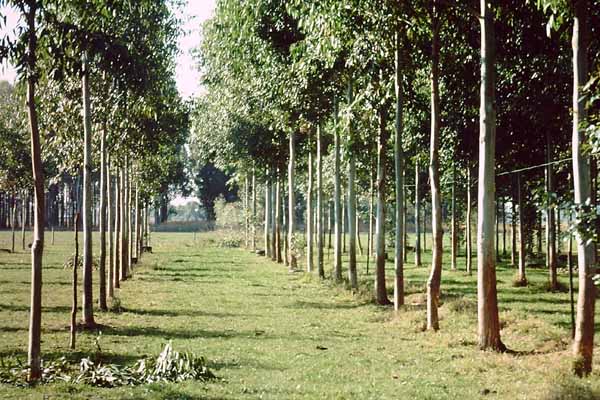
4 year old Flooded Gum at the Mildura Sewage Farm
1981
Source: H Stewart
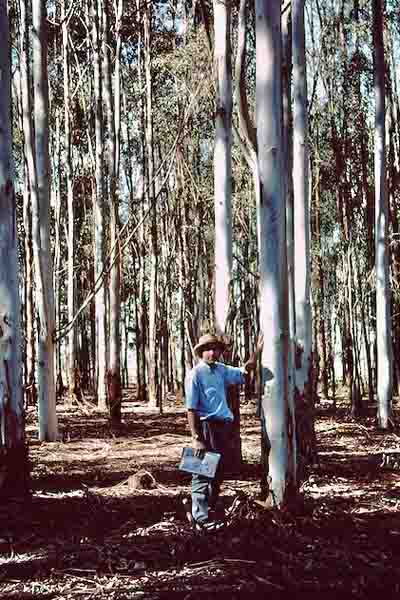
Hugh Stewart in Flooded Gum (age 15 years) at Kyabram
1991
Source: H Stewart
In 1993, the Centre for Forest Tree Technology (1993-1998) set up a short rotation coppice trial irrigated with wastewater at the Shepparton Wastewater Treatment Complex. At age four years, growth rates in the trial were amongst the highest reported in Australia, with the MAI of Blue Gum up to 36 cubic metres per hectare per annum (Duncan et al. 1998).
Another trial was planted at Merbein (1977, 1.6 ha) in cooperation with Mildara Wines and irrigated with winery wastewater. The Kyabram trials using agricultural irrigation water were extended in 1976 with a planting density experiment and a test of 31 provenances of four Eucalypt species – Flooded Gum, Sydney Blue Gum, Blue Gum, and Red Gum. This trial proved again the superior performance of the Lake Albacutya provenance of Red Gum.
Site preparation at most sites included cultivation and formation of mounds, and pre-planting weed control. Most trials were setup as replicated, randomized designs, and planted at a density of 2,222 trees per hectare. Irrigation was either applied by flooding, via sprinklers or via micro-sprays. More than 60 species were tested from a wide range of genera – the best performers were Eucalypts, Casuarinas, and Poplars.
CSIRO (Robin Cromer) started trials in the mid-1970s irrigating Radiata Pine with wastewater at Dutson Downs, south Gippsland. The Dutson Downs farm of 10,000 hectares had about 1,000 hectares of irrigated pastures for disposal of the wastewater. In 1977, the Latrobe Valley Water and Sewerage Board, CSIRO, APM Forests and the Forests Commission started a three-year study in which 15-year-old Radiata Pine was fertilised and irrigated with wastewater. Irrigation doubled plantation growth over the treatment period. (Stewart 1985)
Flow on Studies
Across sites, the research examined survival and growth (Edgar & Stewart 1978, Stewart & Flinn 1984) , herbicides for spraying over trees post-planting (Flinn et al. 1979), correction of iron deficiency on trees irrigated with wastewater (Stewart et al. 1981), the durability of posts harvested from 5-year-old trees irrigated with wastewater (McKimm 1984), impacts on watertables (Heuperman & Stewart 1984), economics (Stewart & Salmon 1986), effects on biomass, nutrient cycling, and soils (Stewart et al. 1985, 1990; Hopmans et al. 1990), root density and distribution (Baldwin & Stewart 1987), and water use (Jim Morris working with Peter Attiwill from The University of Melbourne).
At the same time, Jim Morris was doing ground-breaking research on the salinity tolerance of trees. By 1988 he was confident that a range of species (e.g., Red Gum, Yate ( E. occidentalis) and Casuarinas) could be irrigated with water of 6,000-8,000 ppm salinity, about the level of the salinity of groundwater in the Murray-Goulburn region. In later years he extended this field work to Pakistan and southern China.
Results were first documented in the Research Branch Report series developed by the Division of Education and Research, Forests Commission. Selected reports were then published in journals. As was the practice of the time, authors of papers published in peer-reviewed international journals received reprints of the paper for distribution. The Research Branch was inundated with written requests for reprints of the papers reporting results of the wastewater irritation trials, many from overseas.
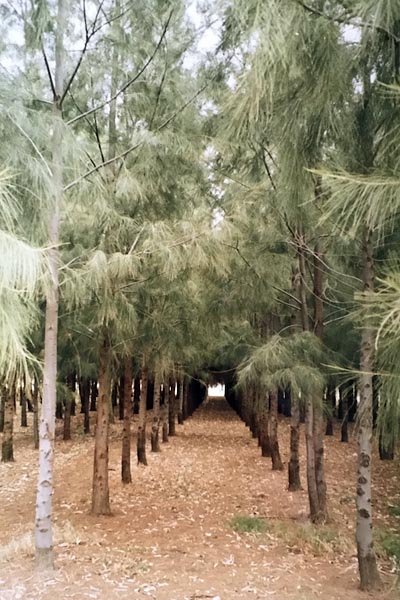
3 year old River Sheoak at the Red Cliffs Sewage Farm
1985
Source: H Stewart
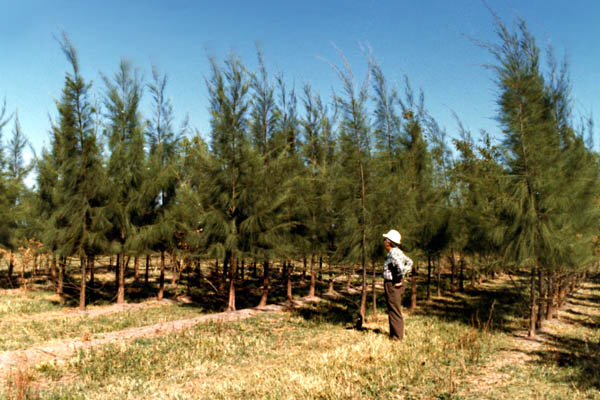
JD Gillespie at a plantation of River Sheoak - probably irrigated by waste water from a Sunraysia winery.
March 1980
Source: S Gillespie
People
People from the Forest Commission (and its successors) involved in the research and development included John Jack, Fred Craig, Barrie Dexter, Jim Edgar, Bob McKimm, Hugh Stewart, David Flinn, Peter Baldwin, Jo Sasse, Leon Pederick, Ray Brash, George Minko, Peter Hopmans, Max James, Leon Bren, Barry Tompkins, John Collopy, Ian Moller, Ross Bickford, Keith O’Brien, Matt Kitching, Helen Cupper, Geoff Salmon, Tom Baker, Michael Duncan, Des Stackpole, Tony Manderson, and Fred Neumann. Divisional and District foresters that supported the work in various ways included Geoff Williams (the regional ‘champion’ of the idea), Peter Brown, Joe Adams, Noel Birch, Norm Cox, Russ Ritchie, Rob Youl, Jack Gillespie, Ken Sheldon, Graeme Saddington, Geoff Beilby, Keith Gidley, Derrick Rolland, Denis Martin, Dave Hocking, Euan Ferguson, Bruce Wehner, and Scott Shaw. Forest extension staff played an important role – Peter Langley, Rob Youl, Kevin Ritchie, Arthur Lyons, Gregor Wallace, Peter Young and Bill Middleton.
Other contributors were Terry Hillman and John Aney, Albury Wodonga Development Corporation; Peter Sandell, Northern Territory Conservation Commission; Ted Allender, Land Energy, Macclesfield (and subsequently the proprietor of Arborline nursery, Hamilton); Pat O’Shaughnessy, David Hutchinson, Nick Ronan, and Richard Benyon, MMBW; and Bruce Cockcroft, Animal and Irrigated Pastures Research Institute, Kyabram.
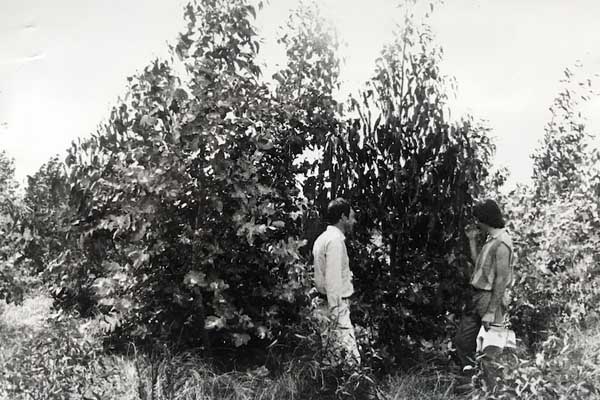
Jim Edgar (l) and Hugh Stewart at the Mildura Sewage Farm
1978
Source: H Stewart
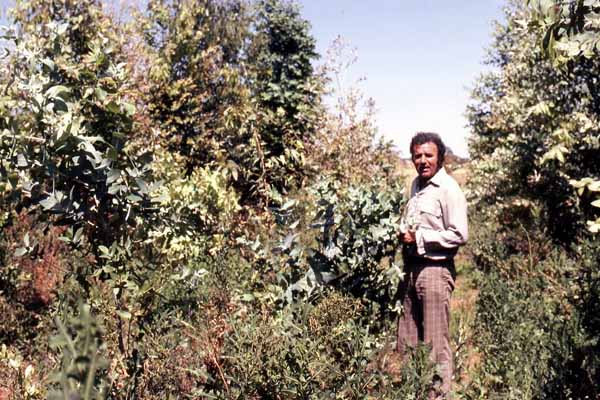
Bob McKimm at the Robinvale Sewage Farm
1980
Source: H Stewart
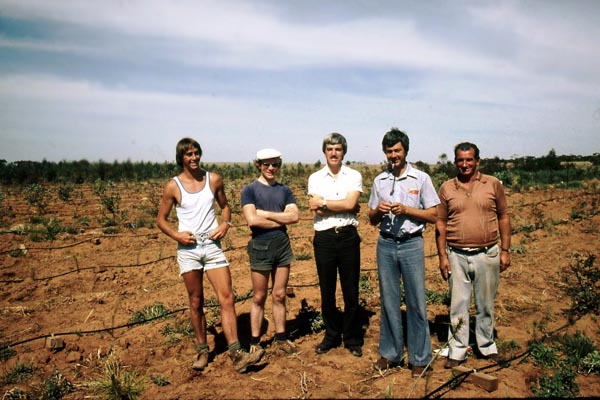
Peter Baldwin (l), Jim Morris, Max James, David Flinn, ?, at the Robinvale Sewage Farm
1979
Source: H Stewart
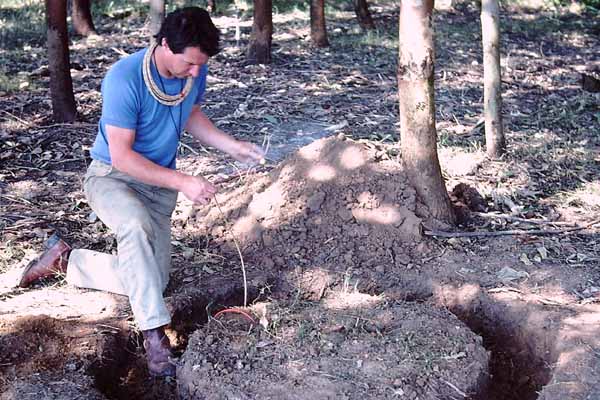
John Tremain conducting root biomass studies at the Wodonga trial
1984
Source: H Stewart
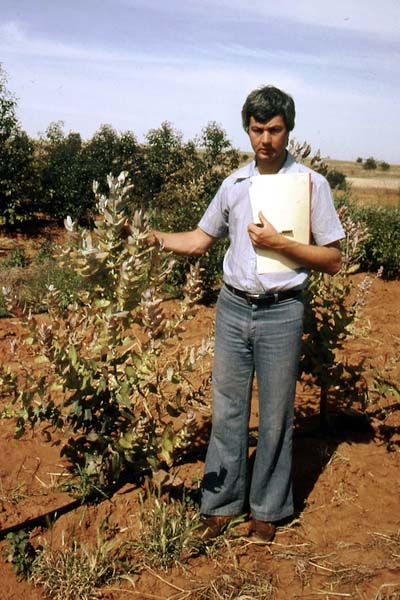
David Flinn at the Robinvale Sewage farm - iron deficiency in Blue Gum
1980
Source: H Stewart
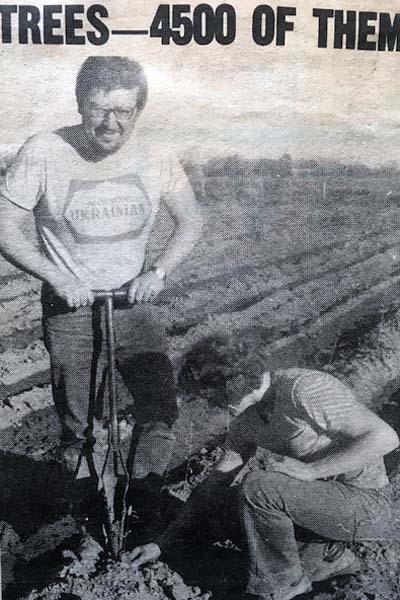
Andy Steiner (l) and Ross Bickford at the Kyabram Research Station
1976
Source: H Stewart
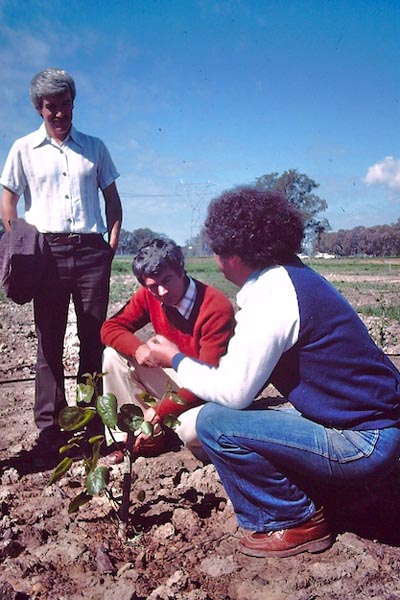
Max James (l), David Flinn, Terry Hillman at a trial planting in Wodonga
1980
Source: H Stewart
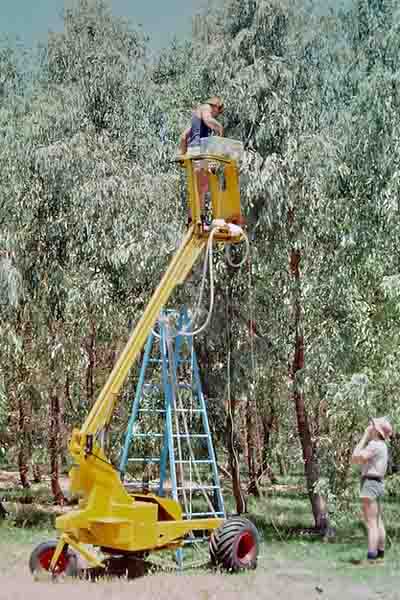
Tree water use studies at the Mildura Sewage Farm. Peter Baldwin (in the canopy) and Jim Morris
1981
Source: H Stewart
Extension
Conferences
Apart from publishing the results of the research, the information was presented at a range of conferences and other forums. Results were first presented publicly at the AFDI (Australian Forest Development Institute) conference at Traralgon in 1977 by Jim Edgar and Hugh Stewart in the session ‘Trees, forests and effluent disposal’. [The wine and cheese tasting session on the first night was slated from 7.30 to 10 p.m.!] The ‘International Conference on Developments in Land Methods of Wastewater Treatment and Utilisation’, Melbourne, October 1978, was convened by MMBW. Jim Edgar and Hugh Stewart presented results of the trials in northern Victoria. At the conference field trip to Werribee, Alan Croxford, chair of MMBW, performed his notorious stunt of sculling a glass of secondary treated wastewater in demonstration of its ‘purity’.
Further results were presented (Fred Craig, Barrie Dexter, Hugh Stewart) at the ‘Symposium on Wastewater Renovation Using Trees’, held in 1979 at Albury, and sponsored by the Murray Valley League. At the symposium, MMBW provided results of species trials at Werribee, noting the superior performance of Blue Gum and the poor performance of Radiata Pine. The keynote speaker was Bill Sopper, Professor of Forest Hydrology, Pennsylvania State University. Barrie Dexter, Hugh Stewart, and Geoff Wilson (AFDI) chaperoned him on a whirlwind tour of projects along the River Murray from Mildura to Wodonga prior to the symposium.
Data on the trials was provided to Mike Smith, State Rivers and Water Supply Commission, to be presented in a paper on ‘Re-use of water in Australia’, at a conference in 1981 in Capetown. Hugh Stewart made a presentation to the Australian Water Works Operators conference at Swan Hill in July 1981, and at a meeting later that year of the Industrial Promotions Committee, Mildura, regarding the re-use of irrigation drainage water to grow tree crops. (The long-standing practice was to use evaporative basins to dispose of such water.) A Parliamentary Joint Select Committee on Salinity inspected the Mildura trial in July 1983. The following month, a group of coalition party politicians – State and Federal – and local municipality representatives inspected the trials, with the Forests Commission represented by Barrie Dexter and Hugh Stewart.
The Reclaimed Water Committee (of which Fred Craig became a member in 1981 because of the success of the trials) made tours of the research sites at Mildura and at other locations in 1978, and in 1981 (twice). The committee then conducted a seminar at the Vegetable Research Station at Frankston in 1982 in which the focus was agronomic, bacteriological, viral, and heavy metal studies of vegetable crops irrigated with wastewater; Hugh Stewart presented results of the Forest Commission trials. [Interestingly, well-known gardener and media personality, Kevin Heinze, attended.] In November 1985, the committee conducted a ‘Recycled Water – Marketing a Valuable Resource’ seminar at Bendigo; Hugh Stewart presented updated results of the trials. Through the committee, the Ministry of Water Resources and Water Supply contributed $120,000 – 1984 dollars) to the research over the period 1977-1984.
The River Murray Commission joined in, organising a seminar on ‘Off-river Disposal of Treated Sewage Effluent to Reduce Nutrient Levels in the River Murray’, held at Wodonga in 1984. The issue at stake was how to deal with the high nitrogen and phosphorus loads of treated wastewater (conventional treatment removed most of the bacteria and other disease-causing organisms but not the nutrients), that led to eutrophication if discharged to rivers. Hugh Stewart presented results, and John Langford, Department of Water Resources, Victoria, presented on opportunities for re-use of wastewater in metropolitan Melbourne, with a focus on irrigation of vegetable crops at Cranbourne. At ‘The International Forestry Conference for the Australian Bicentenary, held in 1988 at Albury, and organised by the Australian Forest Development Institute, Hugh Stewart presented an international review of irrigated forestry with Australian native species.
Extension workshops run by the Forests Commission in 1982, and by its successor Conservation Forests and Lands in 1884, featured visits to some of the trials. For example, the workshop at Benalla in November 1984 visited the Poplar plantings at the Wangaratta Sewerage Authority. This was good for publicity because journalists attended (e.g., from the “Weekly Times”).
Other workshops and conferences followed. An ‘Effluent Re-use’ conference was organised by the Water Research Foundation of Australia and held in Wollongong in February 1990, attended by Hugh Stewart as a speaker on the irrigation of tree crops. The ‘Woodlots Workshop’, held in Mildura in April 1990, was sponsored by the Murray Darling Basin Commission; its policy was to improve the water quality of the River Murray for which it advocated off-river disposal of wastewater by irrigation and evaporation. The commission stated that irrigated woodlots were a viable alternative to the river discharge of wastewaters. The workshop had papers on irrigated woodlots from delegates in Victoria (Hugh Stewart, Conservation, Forests and Lands), NSW, Canberra, and South Australia. A paper was presented on the potential of Jojoba and Blue Mallee ( E. polybractea) for disposal of irrigation drainage water. The field tours included the Mildura Sewage Farm to inspect Red Gum recently planted by the authority in each of the years 1987-1989, the Conservation, Forests and Lands nursery that was producing 270,000 plants per year, and five irrigated woodlots in the region.
Then in July 1991 came a symposium ‘Trees as a Tool for Resource Management in Irrigation Areas’, Tatura Institute for Sustainable Agriculture. It was inspired by the increasing awareness of land degradation related to irrigation, and the opportunity to ameliorate this by planting trees to lower watertables and provide other benefits on irrigated farms. Another theme was disposal of saline drainage water by irrigating salt-tolerant trees given that salt disposal was a key to the sustainability of agricultural irrigation. Speakers included Jim Morris and Hugh Stewart, and delegates from California and India and the Australian Conservation Foundation. Hugh Stewart elaborated on a Conservation, Forests and Lands study convened by Tony Manderson in 1990: ‘Commercial tree planting and salinity control: a feasibility study for northern Victoria’.
Later that year, in December 1991, a national conference on ‘The Role of Trees in Sustainable Agriculture’, under the auspices of the National Agroforestry Working Group, included a workshop ‘Irrigating trees (including irrigation with effluent)’ chaired by Hugh Stewart.
Several consultancies were conducted during the late 1980s-early 1990s. Bob McKimm and Hugh Stewart were part of a team that prepared a feasibility study of a ‘Koorlong Effluent Irrigated Afforestation Project’ in 1989, on behalf of the Sunraysia Board. Later that year, Hugh Stewart teamed up with engineers from MMBW, under the auspices of Victoria’s Overseas Projects Corporation, and travelled to Pakistan to conduct a feasibility study for the United Nations Centre for Human Settlements on the Karachi sewage recycling project. [During the trip the team visited the Karachi Divisional Forest Office to learn about markets for wood products. To the team’s surprise, most of the work of the forestry office centred on the management for fuelwood production of the extensive mangrove areas along estuaries near Karachi.] Another study was done for the NSW Public Works Department on the ‘Jervis Bay Land Application–Irrigated Forest Area’ in 1992. In 1983, Kevin Ritchie inspected wastewater renovation projects in Georgia, USA and in1991, Hugh Stewart travelled to California and Georgia, and to New Zealand to study plantations irrigated with effluents and saline drainage waters.
Advice to Municipal Authorities and Industry
As results of the research were publicized there was a flurry of interest from a wide range of parties. Progress results were provided, sites were inspected, potential projects were evaluated, detailed prescriptions for tree establishment and management were provided, and in many cases, bullish expectations were downplayed. Extensive official correspondence and other records from the period 1978-1982 showed letters and telephone calls from citrus processors seeking options for wastewater discharge; sewerage authorities and/ or their consulting engineers at Ballarat, Balranald, Bendigo, Bright, Clunes, Cohuna, Drouin, Echuca, Geelong, Heathcote, Horsham, Inverloch, Jeparit, Kyabram, Lakes Entrance, Launceston, Lilydale, Maffra, Mallacoota, Mansfield, Maryborough, Melton, Portarlington, Stawell, Tallangatta, Tatura, Tumut, Wangaratta, and Winchelsea; Seppelts Winery at Great Western; ICI Laverton; Felton, Grimwade and Bickford (eucalypt oil producers); Gippsland Northern at Mirboo North re irrigation of trees with wastewater from stock saleyards; Colac Shire Council ditto; Michell & Co. wool scourers, re a land-based treatment system for factory wastewater at Barnawatha North; Lakeside caravan park, Bonnie Doon; Kraft dairy produce factory at Leitchville; Bullers winery, Swan Hill; Shell refinery, Corio.
Enquiries were also received from engineering consultants advising in NSW and South Australia, and about the application of sewage sludge to trees and the use of native forest on crown land for wastewater irrigation (Bendigo, Heathcote, Lakes Entrance). Some overseas enquiries were received (e.g., Agricado Management Corporation, California). As was the protocol of the time, many of the requests were dealt with through Director-level or Ministerial correspondence. Site inspections revealed that many of the proposals to establish trees on the land weren’t viable because of the high salinity of the wastewater and/ or the unsuitability of the soils.
At the time, the Environment Protection Authority in Victoria (EPA) was tightening licence conditions regarding the discharge of secondary treated wastewater to water systems and in many cases prohibiting direct discharge – for example, in 1982 the EPA directed the Horsham Sewerage Authority to stop the discharge of wastewater to the Wimmera River; this followed a concerted campaign by the Dimboola community reacting to the eutrophication of the river. Another factor for the interest in the Forests Commission research was that increased wastewater volumes from population growth were exceeding the capacity of the land disposal systems operated by some authorities, and many of the written responses to these inquiries included data on the water use of trees compared to pasture.
Primary treatment removes settleable solids and floating material by screening and sedimentation; secondary treatment degrades the biological content of the sewage, usually performed by microorganisms under controlled aerobic conditions, e.g., lagoons, trickling filters, aerobic digestors. Authorities typically used lagoons to store treated effluent during the late autumn to early spring period then flood irrigated pastures during the hottest months. Tertiary treatment (eg. coagulation, filtration, activated carbon adsorption of organics, reverse osmosis, and additional disinfection) further reduces organics, turbidity, nitrogen, phosphorus, metals, and pathogens.
Visiting Delegations and other Publicity
In May 1979, at Mildura, Peter Brown, District Forester, and Hugh Stewart hosted a delegation from the Peoples Republic of China, the third group to visit Australia under the bilateral exchange agreement between Academia Sinica, Beijing and the Australian Academy of Science. Their inspection of the trials was widely broadcast in local media.
The trial established in 1980 at Wodonga attracted widespread attention. Visitors included people from State Rivers and Water Supply Commission, Department of Agriculture, Health Department, Environment Protection Authority, Ministry of Economic Development, regional sewerage authorities, consulting engineers, Water Resources Commission of NSW, a NSW Government Task Force, and the Northern Territory Conservation Commission. It was widely reported in regional, and State media (e.g., “The Age”, 28 January 1982, 22 November 1982). Other trials were widely publicised, by “The Age” (‘Tree power’, 21 January 1979; ‘All that waste going to waste, says professor’, 19 April 1979), the “Weekly Times” (‘Effluent used to irrigate pines’, 4 October 1978; ‘Trees help stop pollution’, 9 May 1979), and numerous times by the “Sunraysia Daily”. Hugh Stewart was interviewed on the ABC “Country Hour” in August 1979.
Further extension material was provided by way of a documentary made in 1983 titled “Trees and waste water” that was centred on the Mildura trials and funded by the Reclaimed Water Committee. The Victorian Film Corporation was engaged for the production, Peter Young and Hugh Stewart provided technical advice, and several Forest Commission personnel made the final cut.
In 1980, Geoff Williams, now District Forester at Shepparton, facilitated a meeting for the Shepparton Citizens Employment Committee to explore prospects for establishing irrigated plantations on regional sewerage farms. Hugh Stewart and Robin Cromer, (CSIRO) addressed the meeting.
Records from the period 1988-1989 revealed enquiries from the Rural Water Commission at Mildura, that had tree planting (up to 500 ha on purchased land) as a preferred option for disposal of saline drainage water; MMBW; Murray-Darling Basin Commission (formerly River Murray Commission), acting on behalf of the Department of Defence that had moved its explosives factory from Albury to Mulwala and was seeking a land-based option for effluent disposal; Michell Pty Ltd, re a proposal to build a tannery at Culcairn with wastewater disposal issues; Qld Department of Forestry, responding to requests for information from local municipalities; Australian Paper Manufacturers; Wagga Wagga City Council; consulting engineers to a municipality on the Gold Coast re irrigation of tropical pines with wastewater; and a range of other consultants acting for private clients interested in investing in irrigated plantations (Victoria and NSW).
Research Uptake
In the late 1970s, policy settings in the water industry changed to emphasise beneficial use (coined as ‘re-use’, ‘recycling’) of wastewaters applied to land, rather than the traditional idea of ‘disposal’. The largest commercial forestry undertaking in Victoria was the irrigated plantation of Poplars planted by the Wangaratta Sewerage Authority. Until the late 1970s the authority discharged all secondary treated effluent to Reedy Creek. Low summer flows meant water quality standards could not be met. In 1979 the authority purchased a farm and established 30 hectares of Poplars in 1980-1983 and applied wastewater through a fixed-sprinkler irrigation system. Murray Jarvis and David Wettenhall, Brymay Forests (a subsidiary of Bryant & May), provided Poplar genetic material and were paid as consultants to advise on the silvicultural management of the plantation for peeler logs. The investment was more than $300,000 (1981 dollars) excluding land. Small areas of Eucalypts and Casuarinas were also planted. George Minko reported in August 1982 that 3m tall Eucalypts had been killed outright by frost. Bryant & May ceased Australian match manufacture in early 1987 as a result of import competition, mainly from Sweden. The plantation was clear-felled, and the logs were utilised by Alpine MDF Industries at north Wangaratta?
In 1984, crown land carrying a Forest Commission plantation of Radiata Pine was excised to the Bright Sewerage Authority. Lagoons were constructed from which wastewater was used to irrigate five hectares of plantation.
Several irrigated woodlots were established by horticultural and winery businesses – two irrigated with drainage water (four and 11 ha), and two with winery effluent (including a 20 ha woodlot established by Lindemans at Karadoc). At Red Cliffs in 1982, the Sunraysia Water Board planted a woodlot irrigated with wastewater.
At Laverton, ICI established an irrigated woodlot of 30 hectares between the Princes Highway and Kororoit Creek Rd. Jim Edgar inspected the site in 1978. Large amounts of saline wastewater were produced by the PVC manufacturing process. MMBW was charging $100,000 per year (1978 dollars) to receive the wastewater. The economics of irrigated woodlots were favourable and Flooded Gum was established. The project was successfully established in the early 1980s and for many years could be seen from the Princes Highway. In 2004 the business relocated, and the plantation was converted to a car yard by a vehicle importer.
Other commercial ventures were set up at Loxton in South Australia (a fruit processing business irrigated a 20 ha Eucalypt woodlot with factory wastewater), and at Alice Springs (25 ha site established with Red Gum was irrigated with wastewater and managed for fuelwood production) (Stewart et al. 1986).
The City of Maryborough acted on the idea. A newspaper report (“The Herald”, 9 January 1979) stated:
Forest will cut pollution. A man-made rain forest will be created on the outskirts of Maryborough … the rain forest will be developed on a 30 ha site … Effluent from the Maryborough Sewerage Authority’s treatment works will provide the nutrients for the trees. The scheme will mean effluent can be utilised instead of polluting a nearby creek.
The legendary PA Yeomans (originator of the “Keyline” system of land development), was advisor to the project. The press release turned out to be a bit of a ‘beat up’, but the authority did establish experimental plantings in 1981 with support from the Research Branch of the Forests Commission.
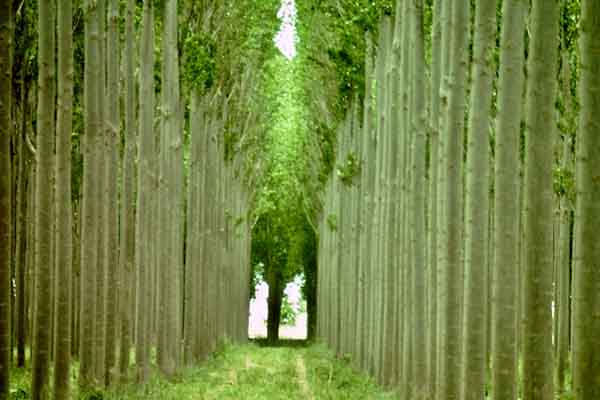
Approx. 10 year old poplar at the Wangaratta Sewage Farm
1991
Source: H Stewart
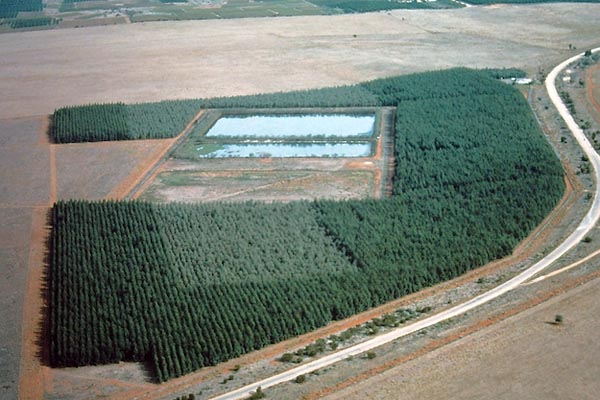
Flooded Gum and Red Gum (6 years old) irrigated with fruit processing wastewater at Loxton, SA
1990
Source: H Stewart
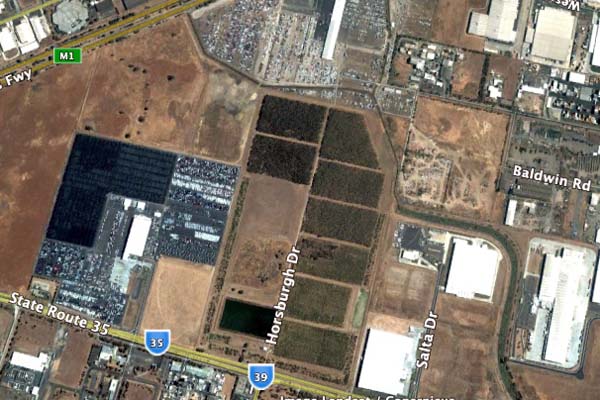
Flooded Gum irrigated with saline wastewater from a PVC manufacturing plant,ICI, Laverton
2004
Source: H Stewart
Other small-scale ‘pilot’ plantings were undertaken, including at Maffra Sewage Farm in 1980-1981 (2 ha) with the support of the Forest Commission Research Branch and under the guidance of Graeme Saddington, District Forester, Maffra. A small area was planted and irrigated at the Cohuna Sewage Farm in 1982, primarily for aesthetic reasons, with advice from Noel Birch and Rob Youl. In 1982, Geoff Williams reported on a project he facilitated in which the Numurkah school had raised and planted 2,000 trees at the Numurkah Sewage Farm. Geoff Williams advised a year later that the Tatura Sewerage Authority planned to establish about 60 hectares of trees, but the project did not proceed as the expected funds from the Government’s unemployment relief budget did not materialize.
In 1984, the Albury Wodonga Development Corporation was seeking funds for establishment of a large-scale wastewater disposal project on the floodplain at Wodonga, incorporating a component of irrigated plantations. The River Murray Commission (Norman McKay) backed the idea. Politics intervened, and it didn’t eventuate.
In 1988, Bruce Wehner provided a snapshot of irrigated plantations operated by sewerage authorities in the Benalla region: Numurkah (10 ha of Sydney Blue Gum and Red Gum planted from 1985-1988), Mooroopna (2 ha of mixed Eucalypts planted in 1984), and Nathalia (1 ha of mixed hardwoods planted in 1987). Ground was being laser-levelled at Shepparton (6 ha for Eucalypts) and at Tatura (40 ha for mixed hardwoods). In 1989, the Kraft factory at Simpson was reported to be setting up a plantation to be irrigated with wastewater – Geoff Beilby had been consulted.
Flow-on Activities
The research on irrigated forestry and salt tolerance of Eucalypts initiated by the Research Branch of the Forests Commission in the 1970s was a catalyst for research elsewhere.
The third national conference on forest soils, and tree nutrition organised by Research Working Group 3 (set up under the Australian Forestry Council), held in 1991, had strong sessions on ‘Trees for reclamation of degraded soils’, and ‘Trees for recycling waste’. Fourteen papers were presented. Organisations represented by presenters included Alcoa Australia; Forestry Commission of NSW; Department of Conservation, Forests and Lands (Jim Morris & Hugh Stewart); CSIRO; Woods and Forests, SA; and MMBW. Bob Boardman’s review paper noted that effluent irrigated forestry (as he coined it) did not receive a single mention 10 years ago at the previous Research Working Group 3 conference. CSIRO presented WATLOAD – an empirical water balance model for scheduling effluent irrigation of wood production plantations. Jim Morris’s paper presented data on water tables and salinity beneath an experimental Red Gum plantation at Whiteheads Creek established in 1979 on a groundwater discharge site.
In 1991, Hugh Stewart and Bob Boardman were contracted by the National Plantations Advisory Committee to prepare a study of the potential for irrigated plantation development in Australia. The final report of the committee – ‘Integrating forestry and farming: commercial wood production on cleared agricultural land’ – contained a recommendation to establish a multi-disciplinary team to design effluent treatment systems incorporating irrigated plantations, and to foster some commercial scale demonstration projects that adopted the design principles.
In 1991, CSIRO (Brian Myers and others) established a trial of the growth and water use of Flooded Gum and Radiata Pine irrigated with effluent, adjacent to the Forest Hills sewage treatment works near Wagga Wagga. The irrigation treatments included salt-laden secondary treated wastewater to allow studies of salt tolerance. Water balance, nutritional physiology, soil chemistry, and nitrogen and phosphorus fluxes were also studied. Brian Myers and colleagues went on to prepare the ‘Australian Guidelines for Sustainable Effluent-irrigated Plantations’, 1999. They observed - "Most of the Australian pioneering research in this field was conducted in Victoria. Early trials in the 1970s, by the then Forests Commission of Victoria …"
State Development, Adelaide, undertook in the late 1980s an effluent disposal study for the Bolivar Sewerage Treatment Works that included evaluation of a large-scale plantation. Trials of irrigated hardwoods were conducted at the site. This led to a project at the Gumeracha sewerage treatment facility east of Adelaide – discharges to the River Torrens ceased in 1996 and all treated sewage is reused on a nearby 15 hectare Radiata Pine plantation. The Department of Agriculture, SA, advertised in 1988 for a research officer to investigate the potential for establishing irrigated native hardwood woodlots for the disposal of drainage water from irrigation areas.
At Ettamogah, NSW, an operational-scale plantation of Radiata Pine (300 ha) was established between 1993-1995 and irrigated with pulp mill effluent from the Norske Skog newsprint mill at Lavington. Standing volume at age 7 years was about 130 cubic metres per hectare. Curly Humphries was a driver of the concept. Peter Hopmans has monitored the soils and plantations for many years. In the late 1990s, pulp and paper mill sludge from a newsprint mill in Tasmania was applied experimentally to Radiata Pine plantations near New Norfolk. The NSW Forestry Commission (John Turner) carried out trials on the application of sewage sludge to Radiata Pine plantations.
Peter Baldwin, now working for the Queensland Department of Forestry, sought in 1989 the most recent results from the Victorian trials, to support an application by the department for funds for trials on tree plantations irrigated with wastewater.
In 1996, Jim Morris revisited the Kyabram plantation (established 20 years earlier) that had been irrigated for the first six years with regular irrigation water. At age eight the trees were shown to be using water from a shallow aquifer, lowering the water table by approximately 2 m compared to the surrounding irrigated pastures. Applying his wizardry for developing gadgets and calculus, he measured transpiration of Flooded Gum and River Red Gum and found that the mature trees were effectively controlling the shallow water table and regulating their water use according to soil water availability.
Tom Baker and colleagues compiled a comprehensive summary of irrigated plantation forest studies in south-eastern Australia in 2005. Readers with further interest in the topic are referred to Baker et. al (2005).
A browse around Google Earth revealed remnants of many of the projects – e.g., Alice Springs, Kyabram, Wodonga 1980 trial (N end of Melrose Drive, plantings relatively intact), Cobram Wastewater Management Facility, 3 ha), Werribee Farm (9 ha); and the ongoing utility of irrigated plantations – e.g., Numurkah Wastewater Management Facility (~12 ha), Shepparton Wastewater Management Facility (~30 ha), Tatura Wastewater Management Facility (~30 ha), and Ettamogah (>150 ha).
New Programs
Back to Victoria, the gap in this narrative during 1986-1987 occurred because I was working in Zimbabwe. Then, the period 1988-1992 was tumultuous: Conservation Forests and Lands (CFL), the mega-department that absorbed the Forests Commission in 1983, became Conservation and Environment (DCE) in 1990, which became Conservation and Natural Resources (CNR) in 1992, followed by the State election in October that year in which the coalition parties led by Jeff Kennett toppled the Joan Kirner-led Labor Government.
Amongst these changes, two new forestry programs emerged. The ‘Trees for Profit’ program was a venture between DCE (the lead agency), the Rural Water Corporation (RWC), and the Treecorp Group (the business operator to develop the commercial aspects of the program independently of government). The objective was to integrate commercial wood production with farming, using plantations, woodlots or timberbelts, to assist in ameliorating land and water degradation. In the dryland country the strategy was to target recharge areas; in the irrigation belt of northern Victoria, the options included plantings irrigated with groundwater, saline drainage water, and wastewaters. A stimulus for the program was a large body of work being done in Victoria and Western Australia on the use of tree plantations for water table control in discharge areas – the idea was that if trees could be sustainably grown in areas with shallow saline groundwater, they offered a means of productively using degraded land of little alternative value beyond the current boundaries of traditional plantation establishment. It heralded a new geographic focus on the idea of combining wood production with the provision of environmental services.
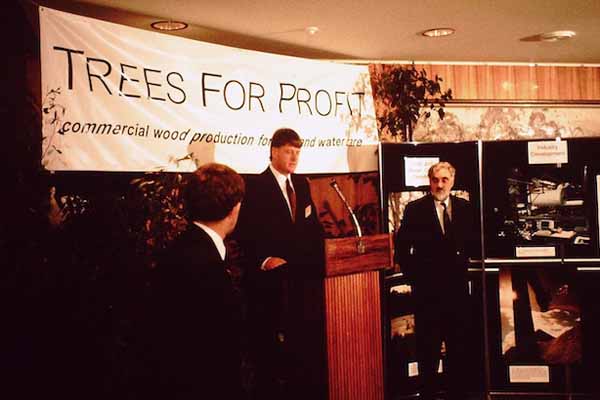
Launch of the Trees for Profit program. Jim Witham (at the podium) and Minister Barry Pullen
July 1992
Source: H Stewart
The program was launched with fanfare in July 1992 by the Hon. Barry Pullen. An important adjunct was the setup in 1991 of the Trees for Profit Research Centre involving DCE, RWC, Department of Food & Agriculture, CSIRO, The University of Melbourne, and Treecorp, investigating such things as forest products, markets, economics, wood quality, silviculture, salinity, and water use. A host of people were involved in the overall program, including Kevin Wareing, Hugh Stewart, Grant Kirby, Jim Witham, Barrie Dexter, Arnis Heislers, David Flinn, Jim Morris, Leon Bren, Phil Dyson, Mike Patto, John Langford, Ian Ferguson, and Bill Rawlins. Winsome McCaughey, Chief Executive of Greening Australia, was an enthusiastic and influential advocate. The program was supported by a Community Liaison Group, in which Jason Alexandra, Australian Conservation Foundation, played an important role. A smaller, companion project was the ‘Shepparton Irrigation Region Agroforestry’ project, originally managed by Hugh Stewart and Grant Kirby in the Commercial Tree Growing section, Forests Branch; implementation was transferred in November 1992 to the Benalla Region, under the management of Peter Clinnick. By the end of 1992, participating landowners in the Goulburn Valley had planted more than 250 hectares, and Tom and Cecily Dumaresq at Undera received national recognition (Banksia Awards) for the agroforestry plantings on their farm.
In 1993, your correspondent joined the Victorian Plantations Corporation, a statutory authority that was created when the plantation forestry function was split from CNR. The above programs continued, but those chapters are for someone else.
Legacy
The Forests Commission and its successors made a considerable investment into this field of research. It was novel, it attracted the interest of a wide range of parties and was one of the earliest examples of multi-disciplinary research, crossing silviculture, hydrology, salinity, nutrition, genetics, soils, and agronomy. Under the strong leadership of Fred Craig, Barrie Dexter and David Flinn, the Research Branch laid the foundation for new knowledge on the suitability and performance of a wide range of trees species in areas outside the traditional forestry ‘domain’. The research was innovative, built new relationships and networks, and was recognised nationally and internationally.
The research was conducted during a period when land-based discharge of wastewater had become the common alternative to the damaging practice of the discharge directly to rivers, lakes or oceans. Tree plantations were seen as an opportunity to utilise larger amounts of applied wastewater than pastures, thus reducing the area of land required for the treatment of wastewater. Other perceived benefits were the relative ease of management of the crop, uptake of heavy metals, dispersal of viruses and bacteria, and amelioration of groundwater and soil.
Ultimately, interest in the concept waned due to such factors as difficulties in maintaining irrigation systems within plantations, lack of silvicultural management, competing interests for the re-use of wastewater, higher regulatory standards for treatment, cost of land proximate to treatment facilities, lingering concerns about ‘leakage’ of nitrogen and phosphorus to potable groundwaters, improvements in the water-use efficiency of manufacturing, advances in wastewater treatment technologies, and so on.
It was recognised from the outset that while such projects would only be small scale and would occupy only a small niche in planted forests, they could make a significant contribution to specific localities where the next best option for dealing with wastewater might otherwise degrade the environment. But, for two decades, it was part of an exciting era in the history of forest research in Victoria.
References
Baker, T., Duncan, M. and Stackpole, D. (2005). Growth and silvicultural management of irrigated plantations. In Nambiar, S. and Ferguson, I. (Eds), New Forests: Wood Production and Environmental Services. CSIRO Publishing, pp. 113-134.
Baldwin, P.J. and Stewart, H.T.L. (1987). Distribution, length and weight of roots in young plantations of Eucalyptus grandis W. Hill ex Maiden irrigated with recycled water. Plant Soil 97: 243-252.
Duncan, M., Baker, T. and Wall, G. 1998. Wastewater irrigated tree plantations: productivity and sustainability. Pap. pres. at 61st Annual Water Industry Engineers and Operators’ Conference, held 2-3 September, 1988, Shepparton, Victoria.
Edgar, J.G. and Stewart, H.T.L. (1978). Trees for effluent disposal in northern Victoria. Wat. Talk 41: 11-15.
Flinn, D.W., Stewart, H.T.L. and O'Shaughnessy P.J. (1979). Screening of weedicides for overspraying Eucalyptus, Pinus and Casuarina on clay soils irrigated with treated effluent. Aust. For. 42: 215-225.
Heuperman, A.F., Stewart, H.T.L. and Wildes, R.A. (1984). The effect of eucalypts on water tables in an irrigation area of northern Victoria. Wat. Talk 52: 4-8.
Hopmans, P., Stewart, H.T.L., Flinn, D.W. and Hillman, T.J. (1990). Growth, biomass production and nutrient accumulation by seven tree species irrigated with municipal effluent at Wodonga, Australia. For. Ecol. Manage. 30: 203-211.
McKimm, R.J. (1984). Fence posts from young trees irrigated with sewage effluent. Aust. For. 47: 172-78.
Stewart, H.T.L., Flinn, D.W., Baldwin, P.J. and James, J.M. (1981). Diagnosis and correction of iron deficiency in planted eucalypts in north-west Victoria. Aust. For. Res. 11: 185-190.
Stewart, H.T.L. and Flinn, D.W. (1984). Establishment and early growth of trees irrigated with wastewater at four sites in Victoria, Australia. For. Ecol. Manage. 8: 243-256.
Stewart, H.T.L. (1985). The effects of fertilisation and wastewater irrigation on the biomass and nutrient content of Pinus radiata D. Don. MSc thesis. The University of Melbourne: Melbourne, Victoria, 169 pp.
Stewart, H.T.L. and Salmon, G.R. (1986). Irrigation of tree plantations with recycled water. 2. Some economic analyses. Aust. For. 49: 89-96.
Stewart, H.T.L., Hopmans, P., Flinn, D.W. and Hillman, T.J. (1990). Nutrient accumulation in trees and soil following irrigation with municipal effluent in Australia. Environ. Pollution 63: 155-177.
Bibliography
Benyon, R., Hutchinson, D., Stewart, H.T.L. and O'Shaughnessy, P.J. (1991). Establishment of eucalypt plantations irrigated with sewage at Werribee, Victoria. In 'Productivity in Perspective' (ed. P.J. Ryan), pp. 107-108. Proc. Third Aust. For. Soils and Nutrition Conf., Melbourne, 7–11 October 1991. Forests Commission: Sydney, New South Wales.
Hopmans, P., Stewart, H.T.L., Flinn, D.W. and Hillman, T.J. (1987). Growth, biomass production and nutrient uptake by seven tree species irrigated with municipal effluent at Wodonga, Australia. Pap. pres. at IUFRO meeting 'Management of Water and Nutrient Relations to Increase Forest Growth', held 19–22 October, 1987, Canberra, ACT.
Morris, J., Mann, L. and Collopy, J. (1998). Transpiration and canopy conductance in a eucalypt plantation using shallow saline groundwater. Tree Physiology 18: 547-555.
Stewart, H.T.L., Craig, F.G. and Dexter, B.D. (1979). Effluent treatment and reclamation in Victoria using tree plantations. Proc. Symposium on Wastewater Renovation Using Trees, April 1979, Albury, New South Wales. Murray Valley League: Albury, New South Wales, pp. 14-18.
Stewart, H.T.L. and Boardman, R. (1991). The potential for irrigated plantation development in Australia. In 'Integrating Forestry and Farming', Appendix B, pp. 95-140, a report of the National Plantations Advisory Committee. Department of Primary Industries and Energy: Canberra, Australia.
Stewart, H.T.L., Flinn, D.W. and Baldwin, P.J. (1982). Irrigation of tree plantations with wastewater in Victoria. 1. Site characteristics, establishment and maintenance procedures, and tree survival and growth between 1977 and 1981. Res. Branch Rep. No. 207. Forests Commission: Melbourne, Victoria, 59 pp.
Stewart, H.T.L. (1984). Field trials of trees irrigated with wastewater in Victoria. Proc. Seminar on Off-river Disposal of Treated Sewage Effluent, 11 November 1984, Wodonga, Victoria. River Murray Commission: Canberra, ACT, pp. 44-45.
Stewart, H.T.L., Allender, E., Sandell, P. and Kube, P. (1986). Irrigation of tree plantations with recycled water. 1. Research developments and case studies. Aust. For. 49: 81-88.
Stewart, H.T.L., Hopmans, P., Flinn, D.W., Hillman, T.J. and Collopy, J. (1988). Evaluation of irrigated tree crops for land disposal of municipal effluent at Wodonga. Tech. Rep. No. 7. Albury-Wodonga Development Corporation: Wodonga, Victoria, 28 pp.
Stewart, H.T.L. (1988). A review of irrigated forestry with Australian native species. Proc. The International Forestry Conference for the Australian Bi-centenary, 25 April to 1 May 1988, Albury, New South Wales. Australian Forest Development Institute: Canberra, ACT, Vol. II of V, 18 pp.
Stewart, H.T.L. (1990). Guidelines for establishment of eucalypt woodlots on irrigated land. Proc. Woodlots Workshop, 10-11 April 1990, Mildura, Victoria. Dept. Agriculture and Rural Affairs: Mildura, Victoria, pp 38-42.
